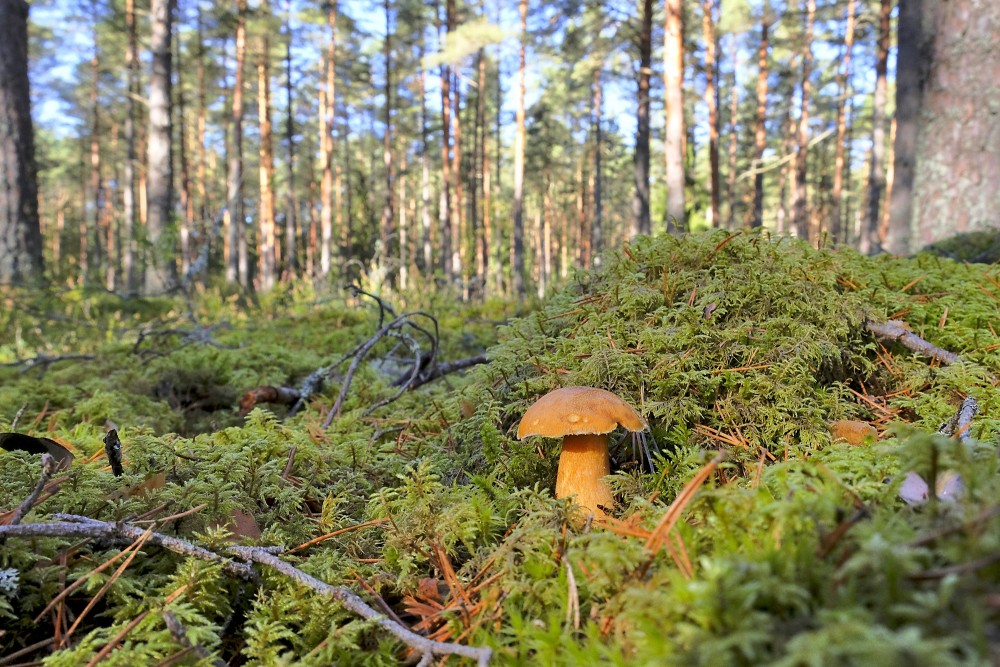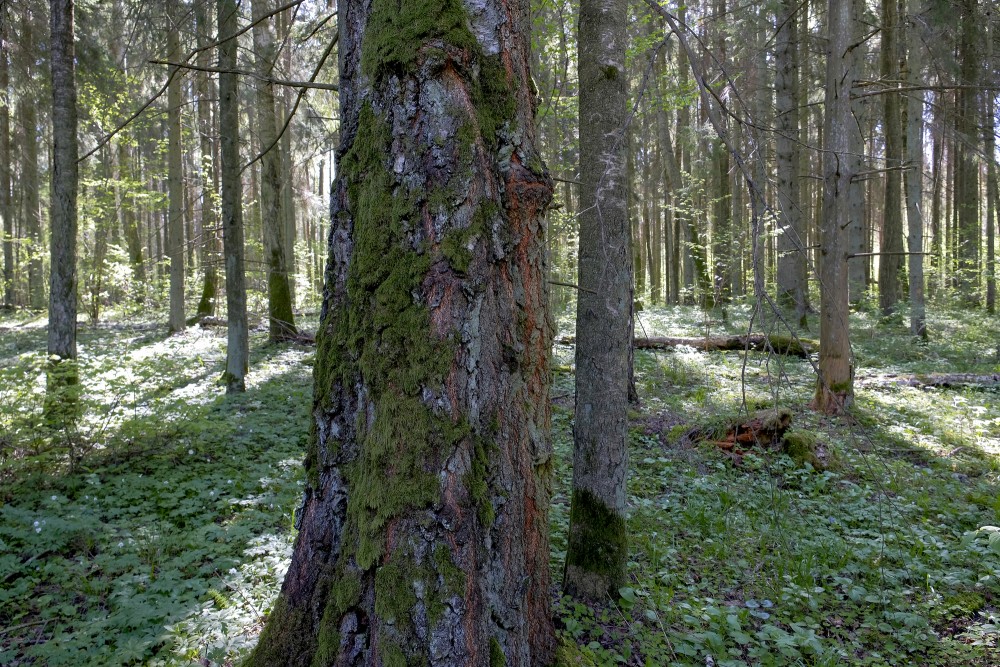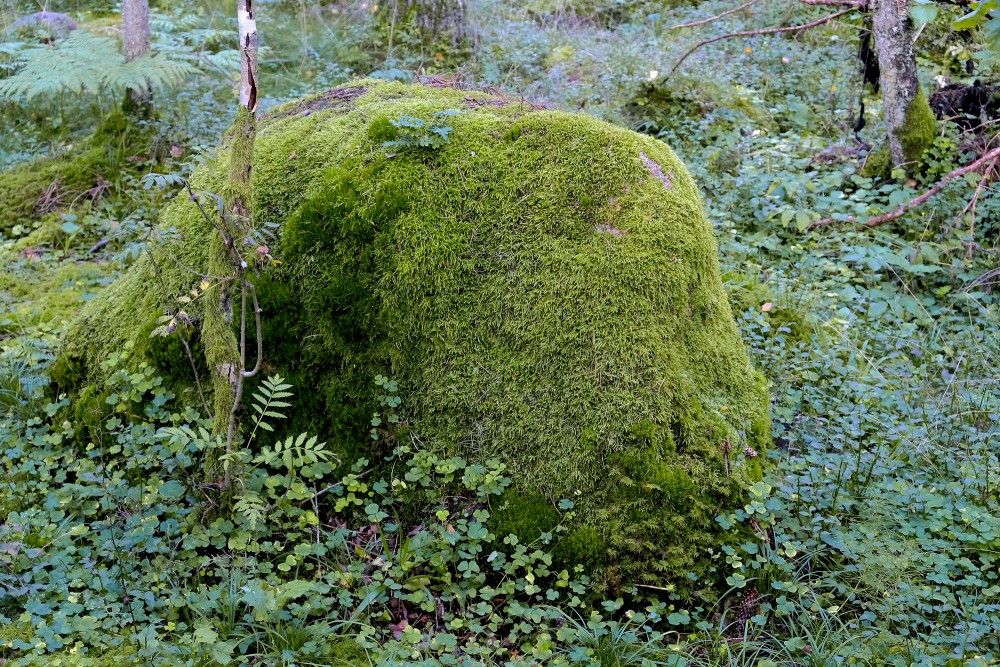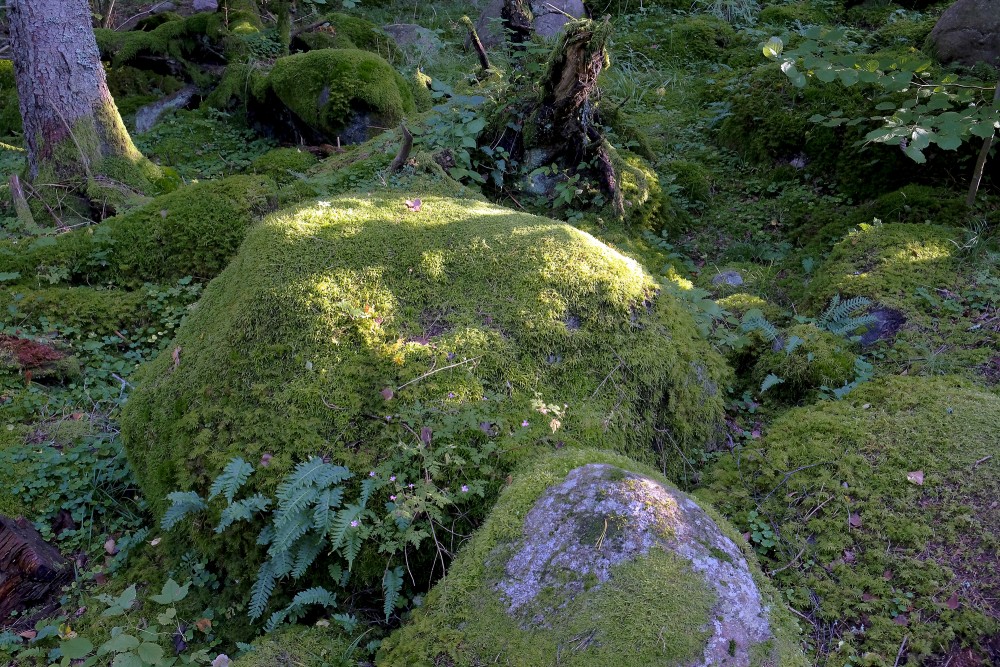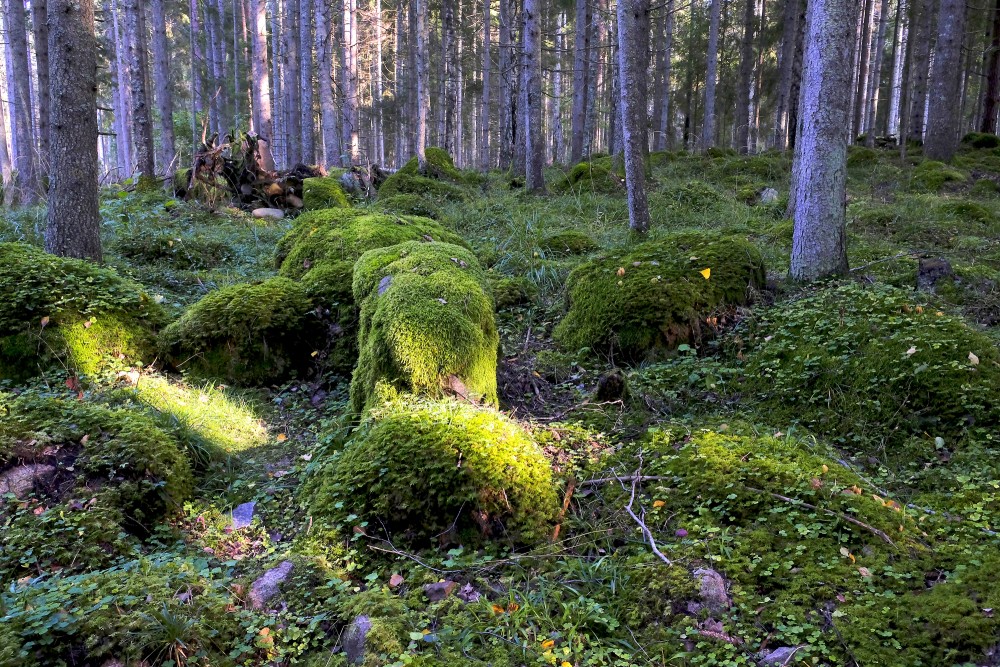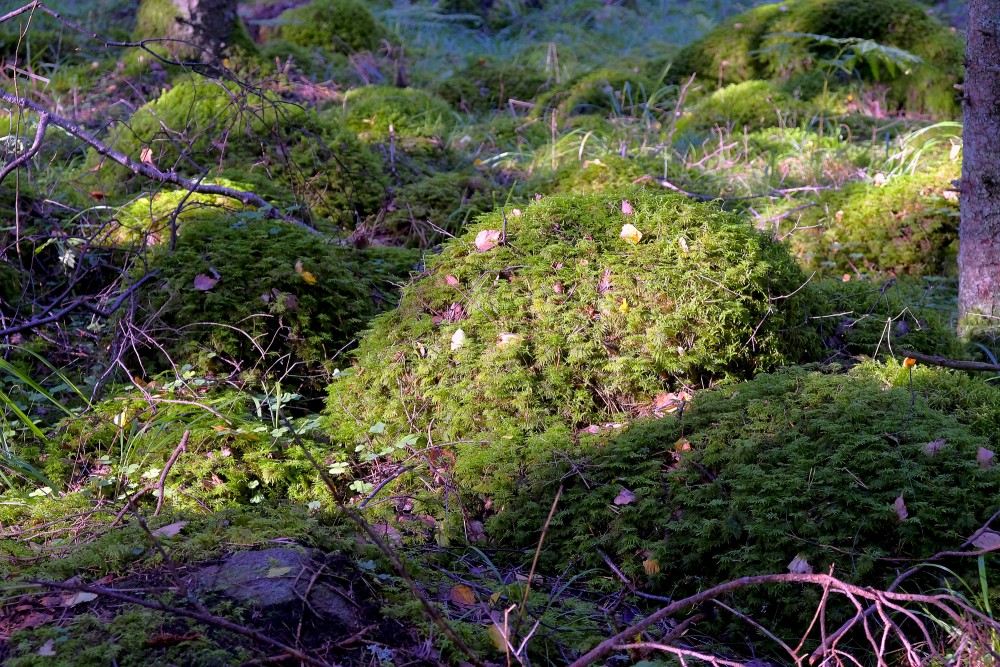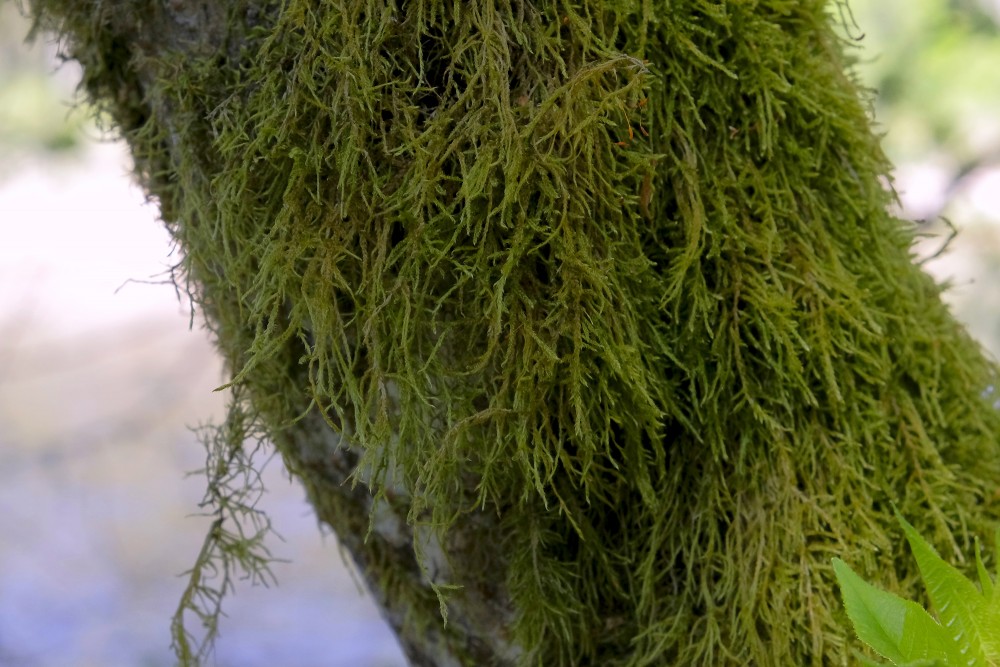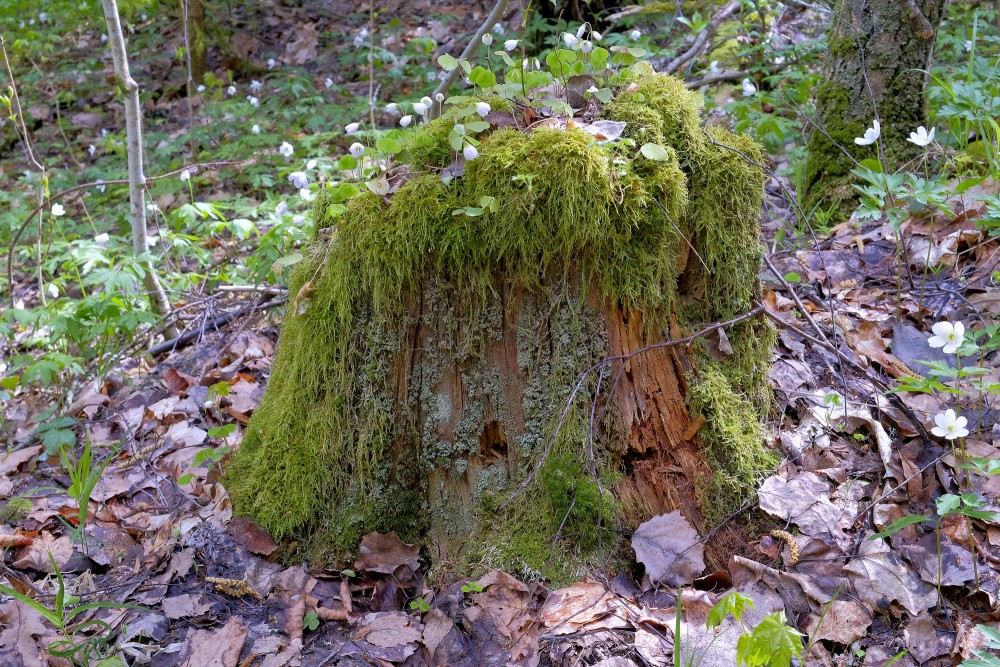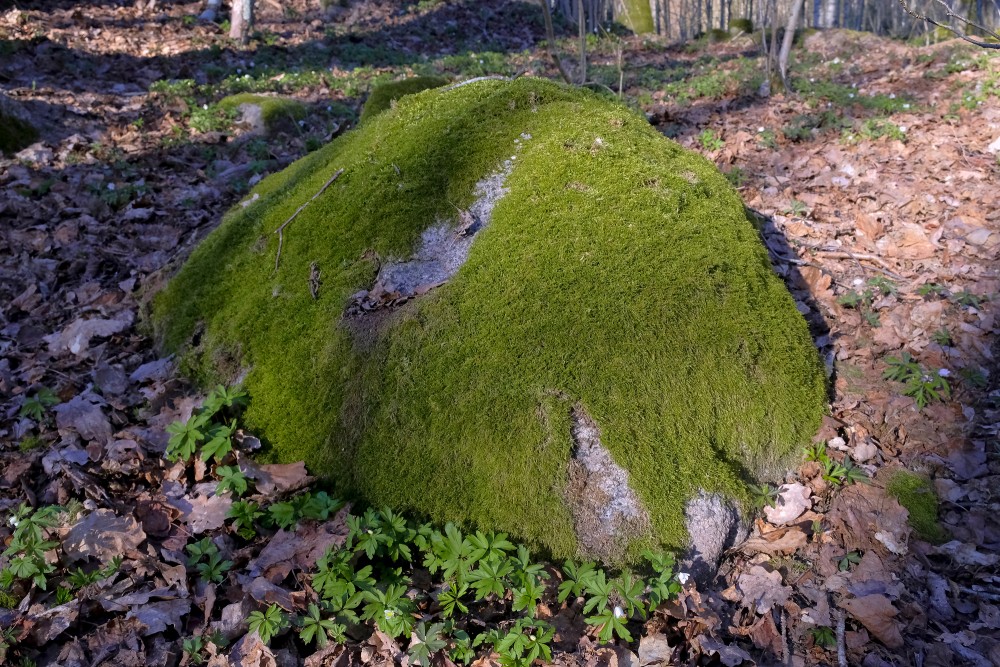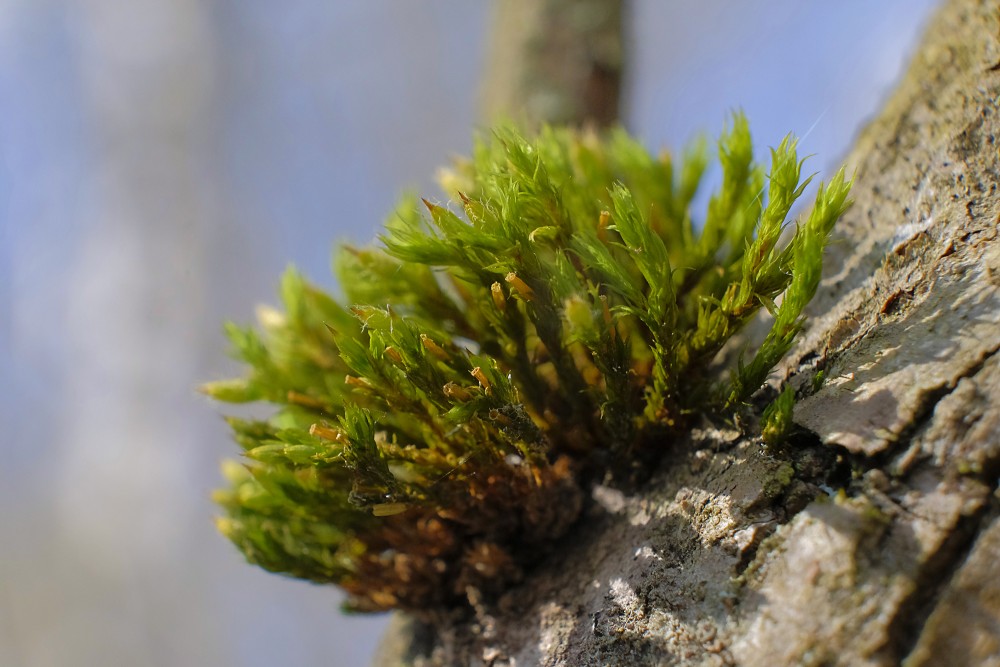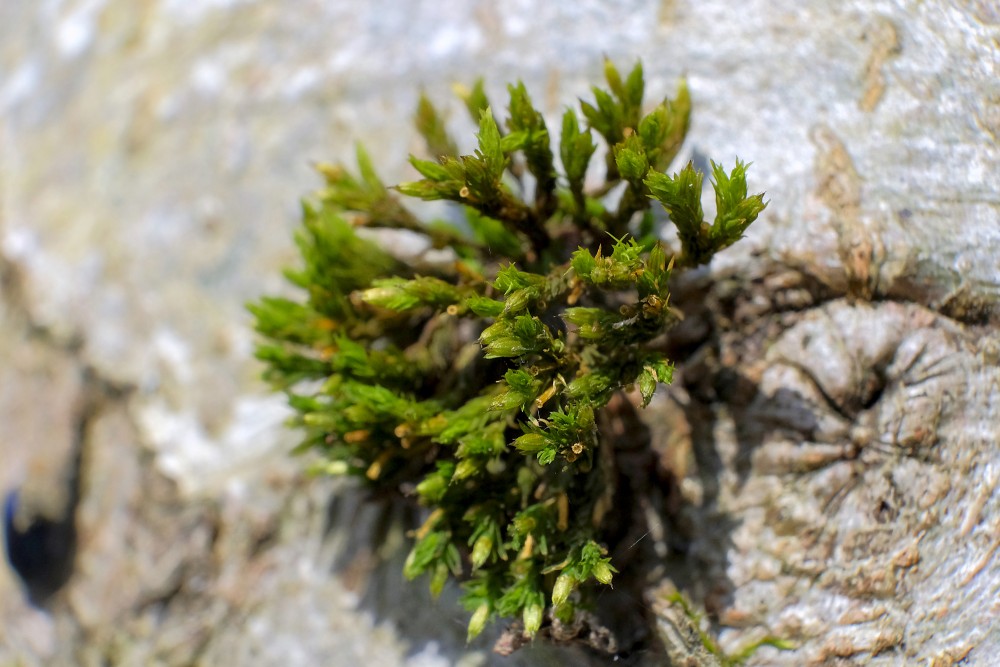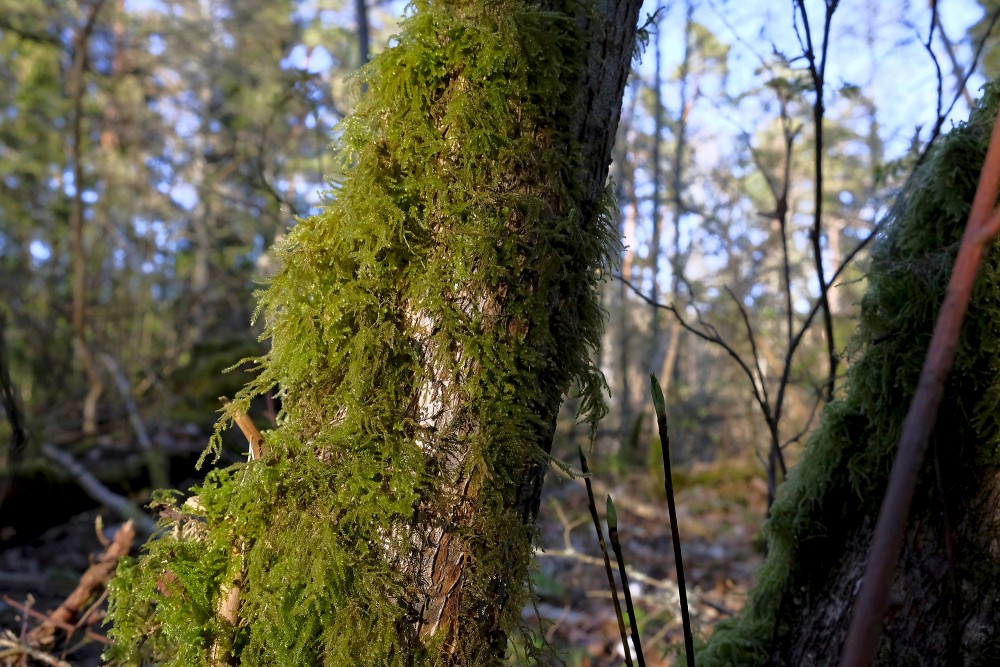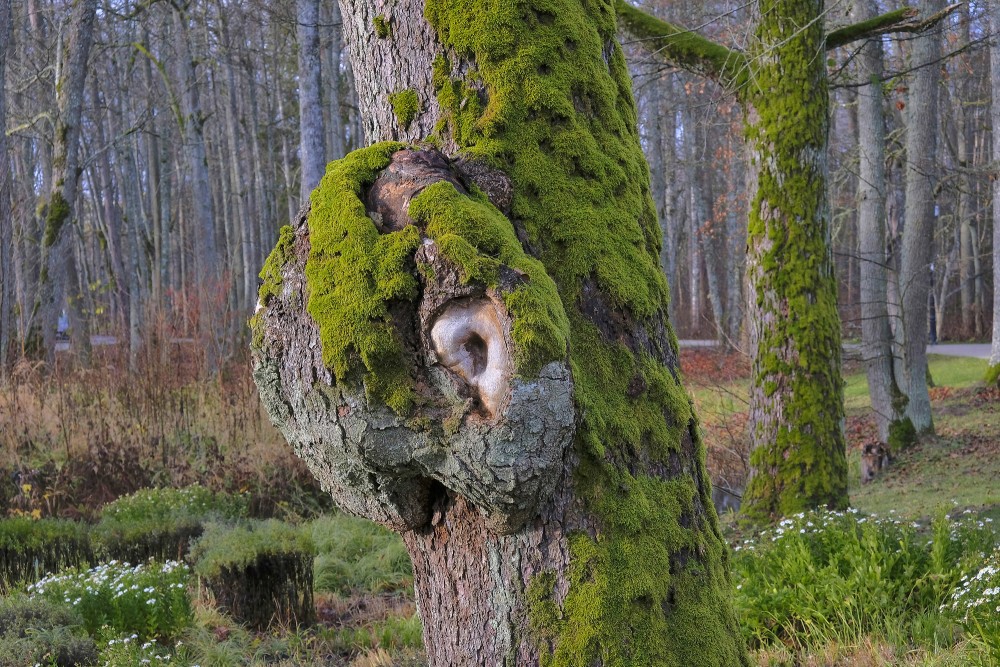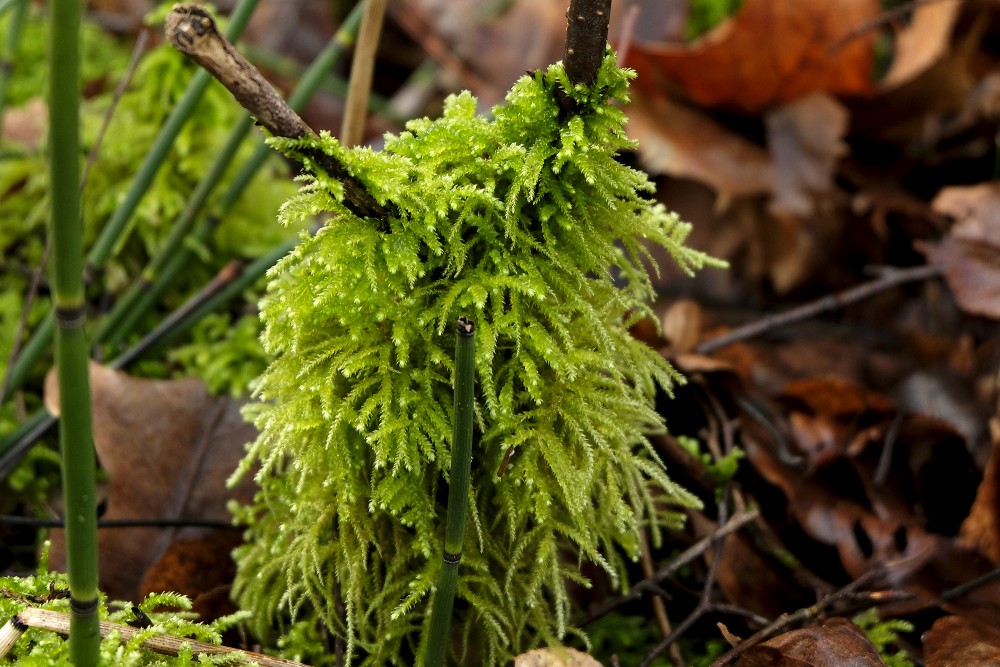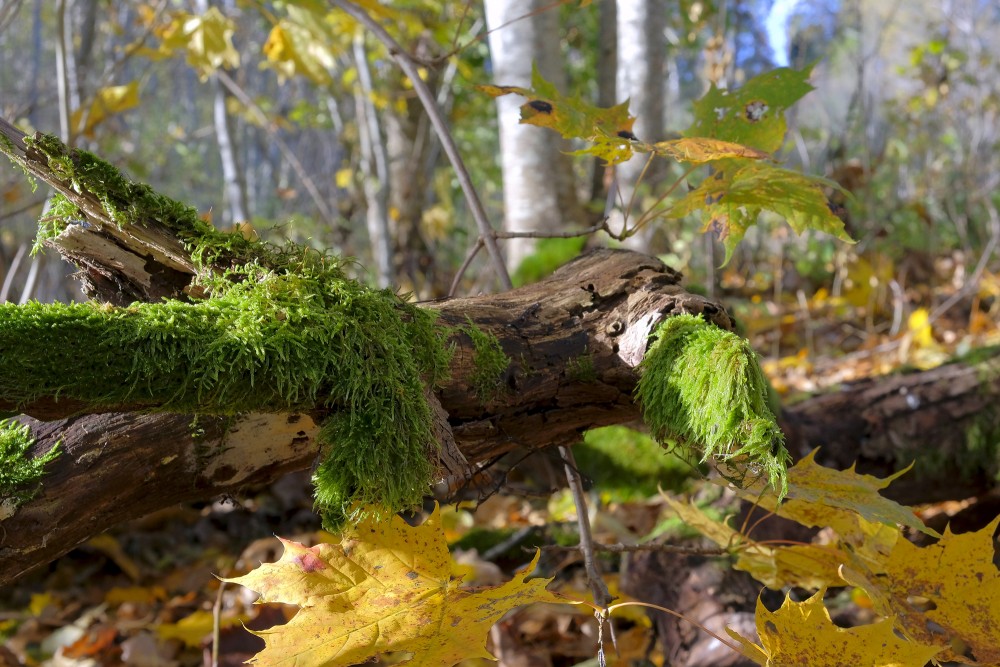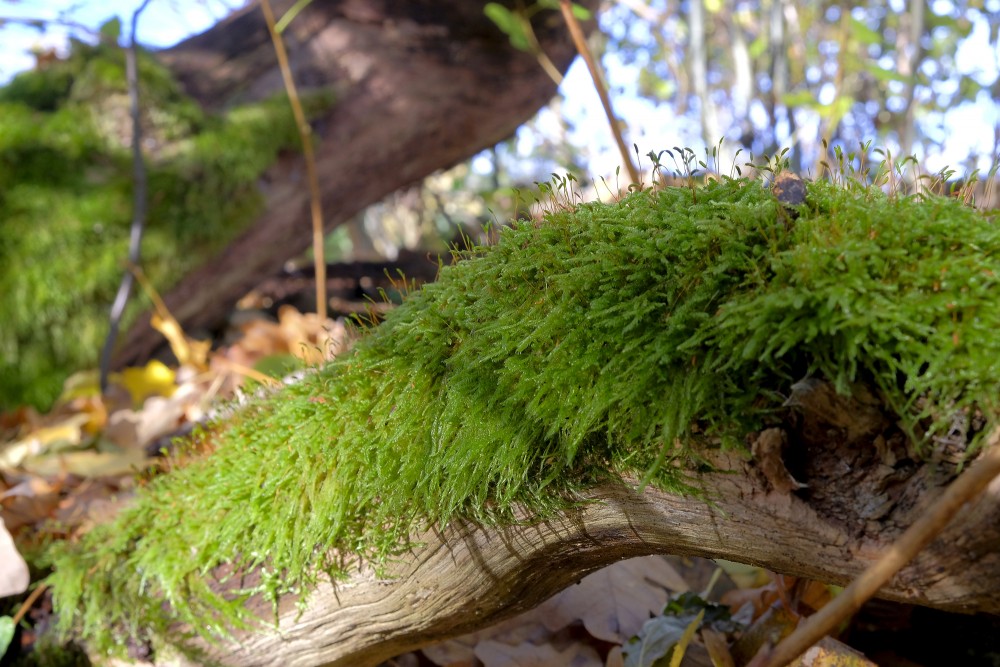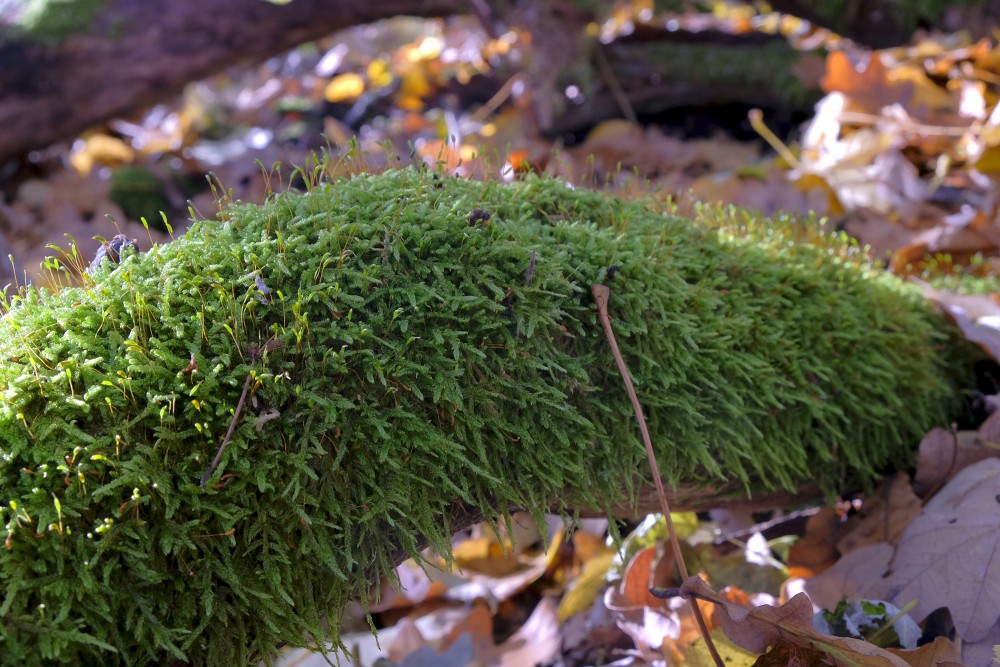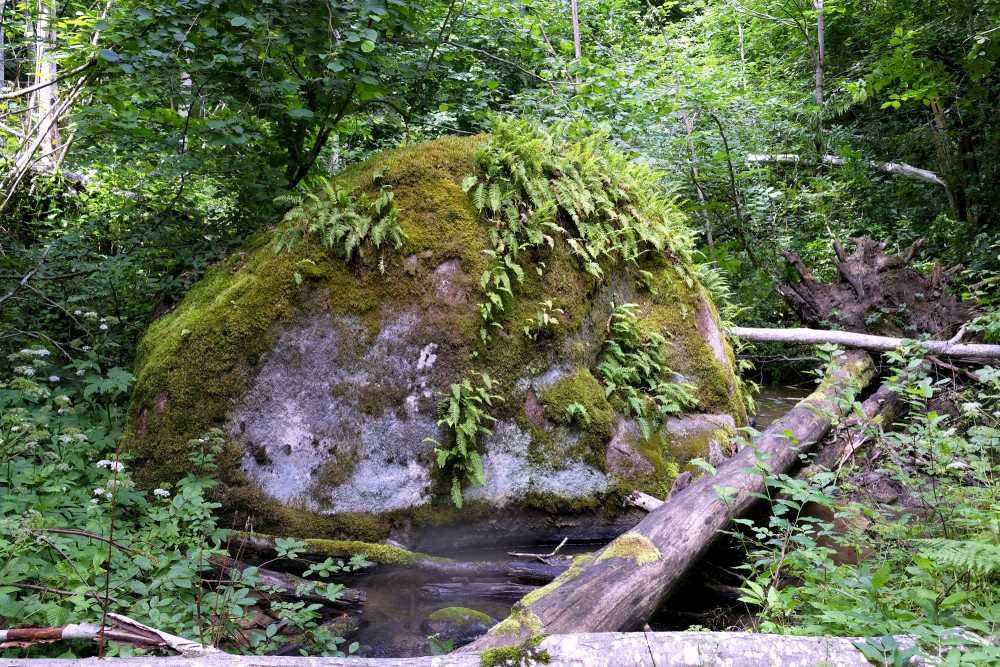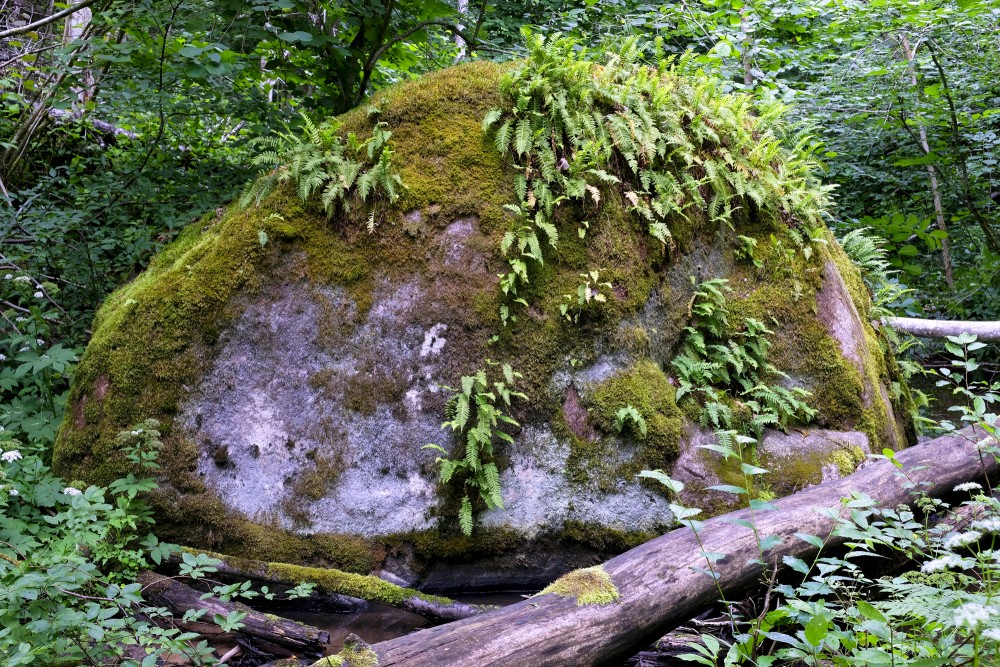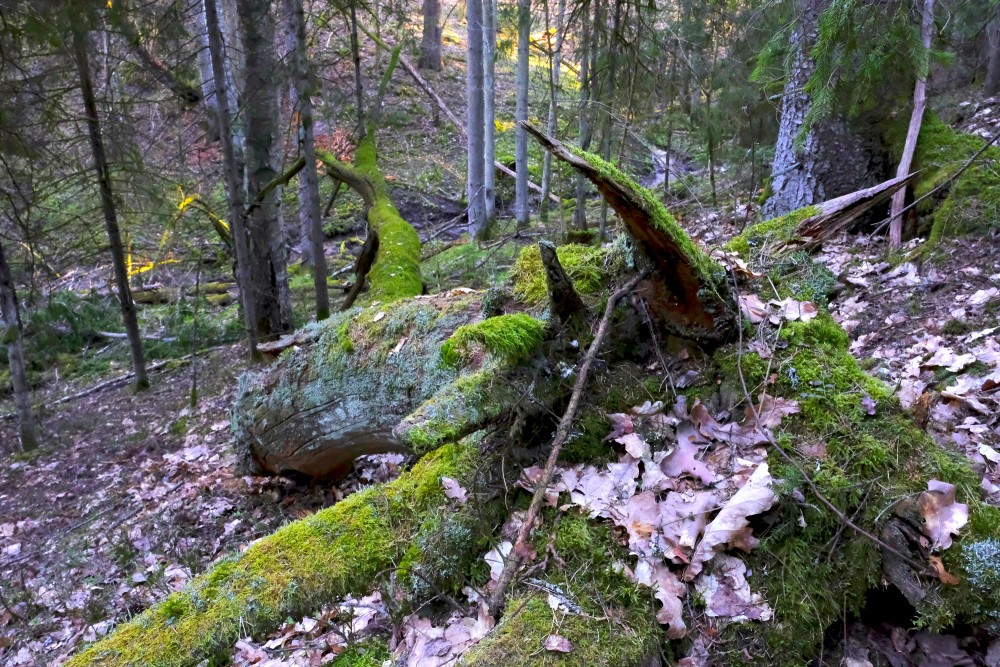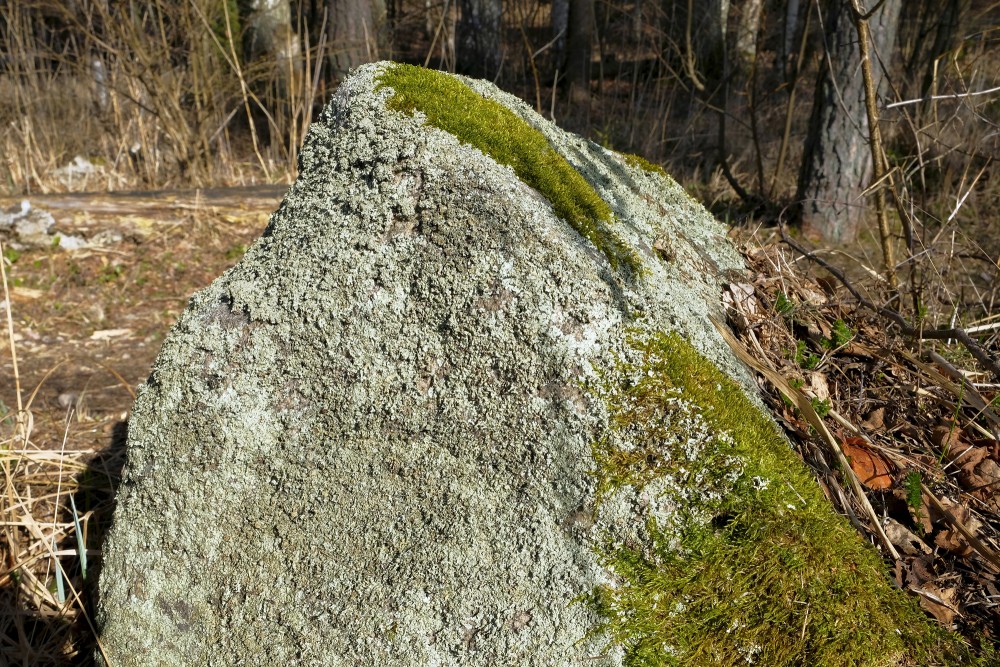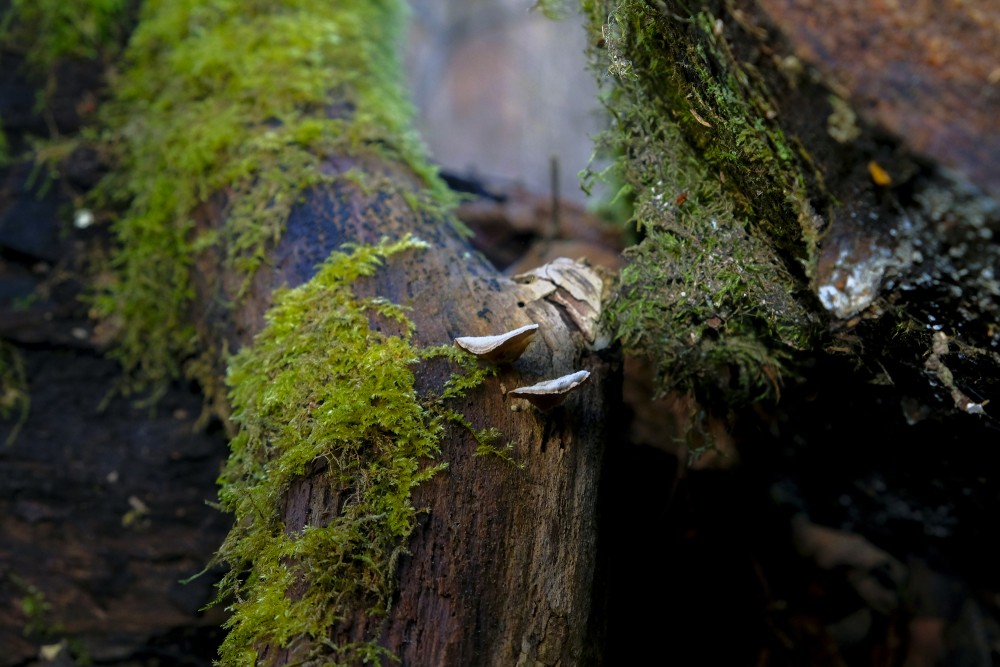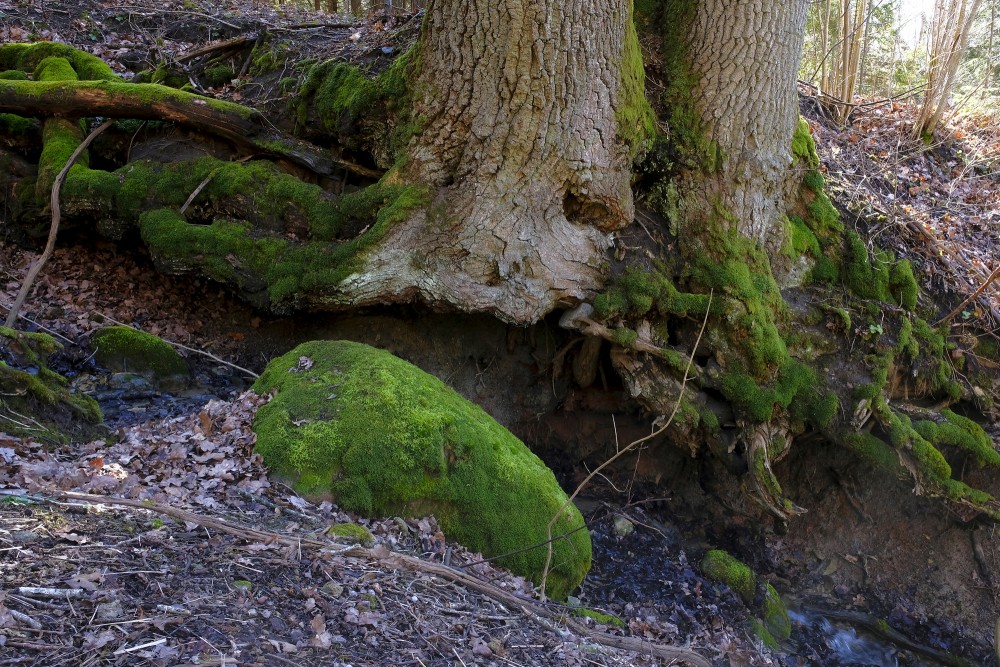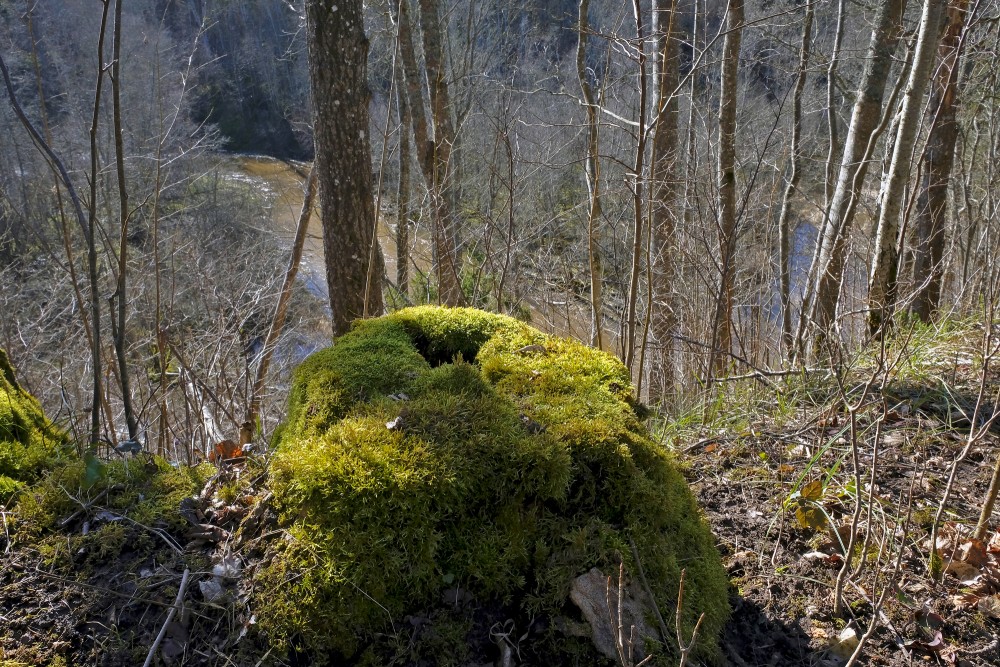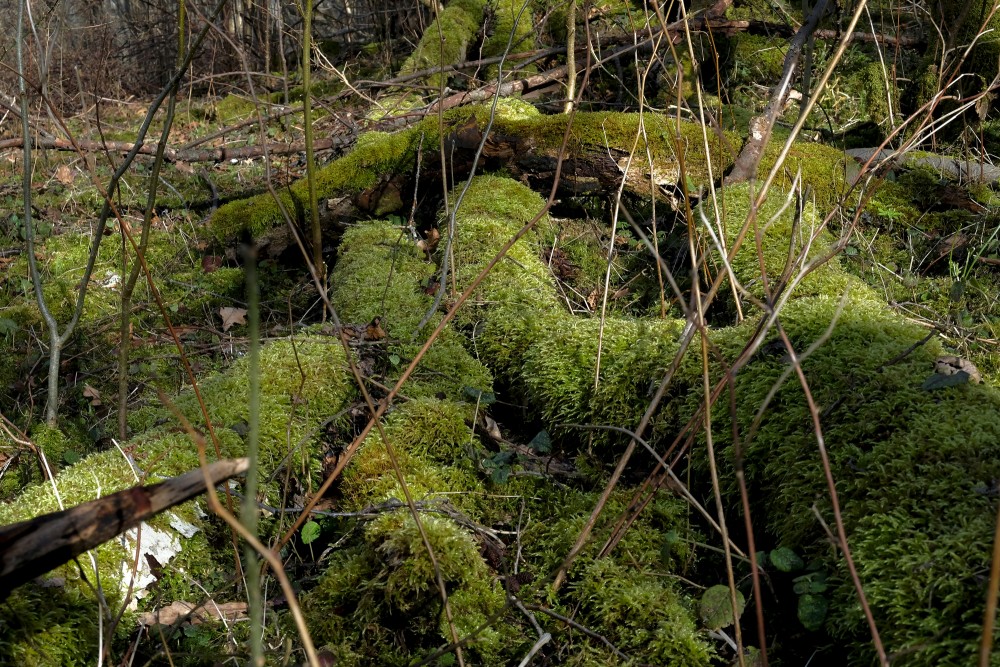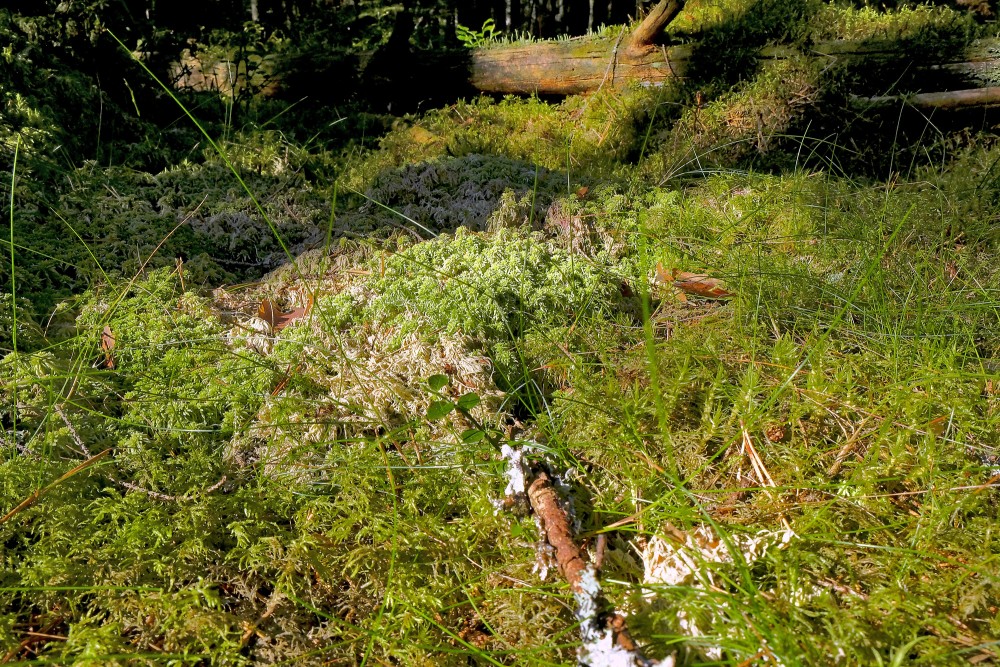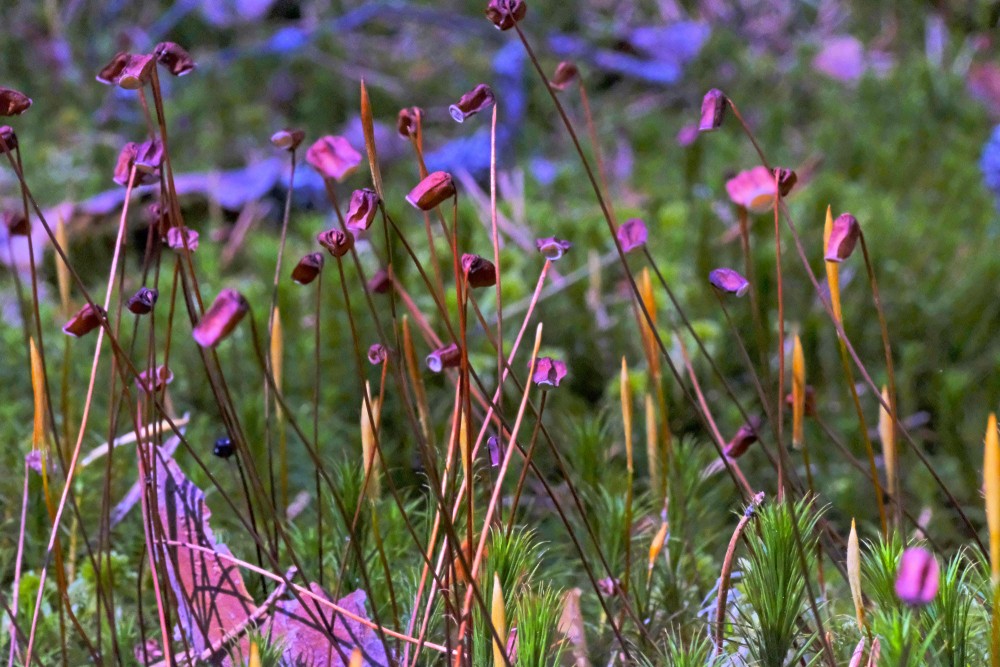Moss
Mosses are small flowerless plants that typically grow in dense green clumps or mats, often in damp or shady locations. The individual plants are usually composed of simple leaves that are generally only one cell thick, attached to a stem that may be branched or unbranched and has only a limited role in conducting water and nutrients. Although some species have conducting tissues, these are generally poorly developed and structurally different from similar tissue found in vascular plants. Mosses do not have seeds and after fertilisation develop sporophytes with unbranched stalks topped with single capsules containing spores. They are typically 0.2–10 cm (0.1–3.9 in) tall, though some species are much larger. Dawsonia, the tallest moss in the world, can grow to 50 cm (20 in) in height.
Mosses are commonly confused with lichens, hornworts, and liverworts. Lichens may superficially look like mosses, and have common names that include the word "moss" (e.g., "reindeer moss" or "iceland moss"), but are not related to mosses. Mosses used to be grouped together with the hornworts and liverworts as "non-vascular" plants in the former division "bryophytes", all of them having the haploid gametophyte generation as the dominant phase of the life cycle. This contrasts with the pattern in all vascular plants (seed plants and pteridophytes), where the diploid sporophyte generation is dominant.
Mosses are now classified on their own as the division Bryophyta. There are approximately 12,000 species.
The main commercial significance of mosses is as the main constituent of peat (mostly the genus Sphagnum), although they are also used for decorative purposes, such as in gardens and in the florist trade. Traditional uses of mosses included as insulation and for the ability to absorb liquids up to 20 times their weight.
Physical characteristics
Description
Botanically, mosses are non-vascular plants in the land plant division Bryophyta. They are small (a few centimeters tall) herbaceous (non-woody) plants that absorb water and nutrients mainly through their leaves and harvest carbon dioxide and sunlight to create food by photosynthesis. They differ from vascular plants in lacking water-bearing xylem tracheids or vessels. As in liverworts and hornworts, the haploid gametophyte generation is the dominant phase of the life cycle. This contrasts with the pattern in all vascular plants (seed plants and pteridophytes), where the diploid sporophyte generation is dominant. Mosses reproduce using spores, not seeds, and have no flowers.
Moss gametophytes have stems which may be simple or branched and upright or prostrate. Their leaves are simple, usually only a single layer of cells with no internal air spaces, often with thicker midribs. They do not have proper roots, but have threadlike rhizoids that anchor them to their substrate. Mosses do not absorb water or nutrients from their substrate through their rhizoids. They can be distinguished from liverworts (Marchantiophyta or Hepaticae) by their multi-cellular rhizoids. Spore-bearing capsules or sporangia of mosses are borne singly on long, unbranched stems, thereby distinguishing them from the polysporangiophytes, which include all vascular plants. The spore-bearing sporophytes (i.e. the diploid multicellular generation) are short-lived and dependent on the gametophyte for water supply and nutrition. Also, in most mosses, the spore-bearing capsule enlarges and matures after its stalk elongates, while in liverworts the capsule enlarges and matures before its stalk elongates. Other differences are not universal for all mosses and all liverworts, but the presence of clearly differentiated stem with simple-shaped, ribbed leaves, without deeply lobed or segmented leaves and not arranged in three ranks, all point to the plant being a moss.
Life cycle
Vascular plants have two sets of chromosomes in their vegetative cells and are said to be diploid, i.e. each chromosome has a partner that contains the same, or similar, genetic information. By contrast, mosses and other bryophytes have only a single set of chromosomes and so are haploid (i.e. each chromosome exists in a unique copy within the cell). There is a period in the moss life cycle when they do have a double set of paired chromosomes, but this happens only during the sporophyte stage.
The moss life-cycle starts with a haploid spore that germinates to produce a protonema (pl. protonemata), which is either a mass of thread-like filaments or thalloid (flat and thallus-like). Massed moss protonemata typically look like a thin green felt, and may grow on damp soil, tree bark, rocks, concrete, or almost any other reasonably stable surface. This is a transitory stage in the life of a moss, but from the protonema grows the gametophore ("gamete-bearer") that is structurally differentiated into stems and leaves. A single mat of protonemata may develop several gametophore shoots, resulting in a clump of moss.
From the tips of the gametophore stems or branches develop the sex organs of the mosses. The female organs are known as archegonia (sing. archegonium) and are protected by a group of modified leaves known as the perichaetum (plural, perichaeta). The archegonia are small flask-shaped clumps of cells with an open neck (venter) down which the male sperm swim. The male organs are known as antheridia (sing. antheridium) and are enclosed by modified leaves called the perigonium (pl. perigonia). The surrounding leaves in some mosses form a splash cup, allowing the sperm contained in the cup to be splashed to neighboring stalks by falling water droplets.
Mosses can be either dioicous (compare dioecious in seed plants) or monoicous (compare monoecious). In dioicous mosses, male and female sex organs are borne on different gametophyte plants. In monoicous (also called autoicous) mosses, both are borne on the same plant. In the presence of water, sperm from the antheridia swim to the archegonia and fertilisation occurs, leading to the production of a diploid sporophyte. The sperm of mosses is biflagellate, i.e. they have two flagellae that aid in propulsion. Since the sperm must swim to the archegonium, fertilisation cannot occur without water. Some species (for example Mnium hornum or several species of Polytrichum) keep their antheridia in so called 'splash cups', bowl-like structures on the shoot tips that propel the sperm several decimeters when water droplets hit it, increasing the fertilization distance.
After fertilisation, the immature sporophyte pushes its way out of the archegonial venter. It takes about a quarter to half a year for the sporophyte to mature. The sporophyte body comprises a long stalk, called a seta, and a capsule capped by a cap called the operculum. The capsule and operculum are in turn sheathed by a haploid calyptra which is the remains of the archegonial venter. The calyptra usually falls off when the capsule is mature. Within the capsule, spore-producing cells undergo meiosis to form haploid spores, upon which the cycle can start again. The mouth of the capsule is usually ringed by a set of teeth called peristome. This may be absent in some mosses.
Most mosses rely on the wind to disperse the spores. In the genus Sphagnum the spores are projected about 10–20 cm (4–8 in) off the ground by compressed air contained in the capsules; the spores are accelerated to about 36,000 times the earth's gravitational acceleration g.[8][9]
It has recently been found that microarthropods, such as springtails and mites, can effect moss fertilization and that this process is mediated by moss-emitted scents. Male and female fire moss, for example emit different and complex volatile organic scents. Female plants emit more compounds than male plants. Springtails were found to choose female plants preferentially, and one study found that springtails enhance moss fertilization, suggesting a scent-mediated relationship analogous to the plant-pollinator relationship found in many seed plants. The stinkmoss species Splachnum sphaericum develops insect pollination further by attracting flies to its sporangia with a strong smell of carrion, and providing a strong visual cue in the form of red-coloured swollen collars beneath each spore capsule. Flies attracted to the moss carry its spores to fresh herbivore dung, which is the favoured habitat of the species of this genus.
In many mosses, e.g. Ulota phyllantha, green vegetative structures called gemmae are produced on leaves or branches, which can break off and form new plants without the need to go through the cycle of fertilization. This is a means of asexual reproduction, and the genetically identical units can lead to the formation of clonal populations.
Dwarf males
Moss dwarf males (also known as nannandry or phyllodioicy) originate from wind-dispersed male spores that settle and germinate on the female shoot where their growth is restricted to a few millimeters. In some species, dwarfness is genetically determined, in that all male spores become dwarf. More often, however, it is environmentally determined in that male spores that land on a female become dwarf, while those that land elsewhere develop into large, female-sized males. In the latter case, dwarf males that are transplanted from females to another substrate develop into large shoots, suggesting that the females emit a substance which inhibits the growth of germinating males and possibly also quickens their onset of sexual maturation. The nature of such a substance is unknown, but the phytohormone auxin may be involved.
Having the males growing as dwarfs on the female is expected to increase the fertilization efficiency by minimizing the distance between male and female reproductive organs. Accordingly, it has been observed that fertilization frequency is positively associated with the presence of dwarf males in several phyllodioicous species.
Dwarf males occur in several unrelated lineages and is showing to be more common than previously thought. For example, it is estimated that between one quarter and half of all dioicous pleurocarps have dwarf males.
DNA repair
The moss Phycomitrella patens has been used as a model organism to study how plants repair damage to their DNA, especially the repair mechanism known as homologous recombination. If the plant cannot repair DNA damage, e.g. double-strand breaks, in their somatic cells, the cells can lose normal functions or die. If this occurs during meiosis (part of sexual reproduction), they could become infertile. The genome of P. patens has been sequenced, which has allowed several genes involved in DNA repair to be identified. P. patens mutants that are defective in key steps of homologous recombination have been used to work out how the repair mechanism functions in plants. For example, a study of P. patens mutants defective in RpRAD51, a gene that encodes a protein at the core of the recombinational repair reaction, indicated that homologous recombination is essential for repairing DNA double-strand breaks in this plant. Similarly, studies of mutants defective in Ppmre11 or Pprad50 (that encode key proteins of the MRN complex, the principal sensor of DNA double-strand breaks) showed that these genes are necessary for repair of DNA damage as well as for normal growth and development.
Ecology
Habitat
Since moss gametophytes are autotrophic they require enough sunlight to perform photosynthesis. Shade tolerance varies by species, just as it does with higher plants. In most areas, mosses grow chiefly in areas of dampness and shade, such as wooded areas and at the edges of streams; but they can grow anywhere in cool damp cloudy climates, and some species are adapted to sunny, seasonally dry areas like alpine rocks or stabilized sand dunes.
Choice of substrate varies by species as well. Moss species can be classed as growing on: rocks, exposed mineral soil, disturbed soils, acid soil, calcareous soil, cliff seeps and waterfall spray areas, streamsides, shaded humusy soil, downed logs, burnt stumps, tree trunk bases, upper tree trunks, and tree branches or in bogs. Moss species growing on or under trees are often specific about the species of trees they grow on, such as preferring conifers to broadleaf trees, oaks to alders, or vice versa. While mosses often grow on trees as epiphytes, they are never parasitic on the tree.
Mosses are also found in cracks between paving stones in damp city streets, and on roofs. Some species adapted to disturbed, sunny areas are well adapted to urban conditions and are commonly found in cities. Examples would be Rhytidiadelphus squarrosus, a garden weed in Vancouver and Seattle areas; Bryum argenteum, the cosmopolitan sidewalk moss, and Ceratodon purpureus, red roof moss, another cosmopolitan species. A few species are wholly aquatic, such as Fontinalis antipyretica, common water moss; and others such as Sphagnum inhabit bogs, marshes and very slow-moving waterways.[6] Such aquatic or semi-aquatic mosses can greatly exceed the normal range of lengths seen in terrestrial mosses. Individual plants 20–30 cm (8–12 in) or more long are common in Sphagnum species for example.
Wherever they occur, mosses require liquid water for at least part of the year to complete fertilisation. Many mosses can survive desiccation, sometimes for months, returning to life within a few hours of rehydration.
It is generally believed that in northern latitudes, the north side of trees and rocks will generally have more luxuriant moss growth on average than other sides. This is assumed to be because the sun on the south side creates a dry environment. South of the equator the reverse would be true. However, naturalists feel that mosses grow on the damper side of trees and rocks. In some cases, such as sunny climates in temperate northern latitudes, this will be the shaded north side of the tree or rock. On steep slopes it may be the uphill side. For mosses that grow on tree branches, this is generally the upper side of the branch on horizontally growing sections or near the crotch. In cool damp cloudy climates, all sides of tree trunks and rocks may be equally damp enough for mosses. And different species of mosses have different moisture and sun requirements so will grow on different sections of the same tree or rock.
Moss-cyanobacteria relationship
In boreal forests, some species of moss play an important role in providing nitrogen for the ecosystem due to their relationship with nitrogen-fixing cyanobacteria. Cyanobacteria colonizes moss and receives shelter in return for providing fixed nitrogen. Moss releases the fixed nitrogen, along with other nutrients, into the soil "upon disturbances like drying-rewetting and fire events," making it available throughout the ecosystem.
en.wikipedia.org
